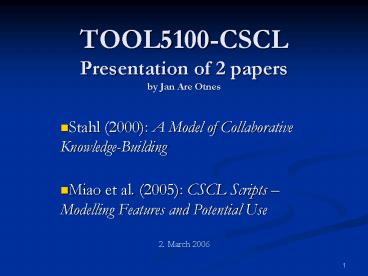TOOL5100CSCL Presentation of 2 papers by Jan Are Otnes PowerPoint PPT Presentation
1 / 18
Title: TOOL5100CSCL Presentation of 2 papers by Jan Are Otnes
1
TOOL5100-CSCLPresentation of 2 papersby Jan Are
Otnes
- Stahl (2000) A Model of Collaborative
Knowledge-Building - Miao et al. (2005) CSCL Scripts Modelling
Features and Potential Use
2. March 2006
2
Stahl (2000) A Model of Collaborative
Knowledge-Building
- Abstract/Introduction
- A Diagram of Personal and Social
Knowledge-Building - Opportunities for Computer Support
- The Idea of a Computer System to Support the
Knowledge-Building Process - Conclusion
3
Abstract/Introduction
- The paper present a model of learning as a social
process - Individual minds in relation to socio-cultural
- Framework for the design of CSCL-SW (KBE)
- 5 theories of learning (Koschmann)
- The paper incorporating insights from these
theories/philosophies - Multiple phases constitute a cycle gt
increasingly complex questions to be posed
4
A Diagram of Personal and Social
Knowledge-Building
5
Opportunities for Computer Support
6
The Idea of a Computer System to Support the
Knowledge-Building Process(1)
- A KBE should
- go beyond a single-purpose system
- retain a record of the knowledge that was built
up - And it should therefore probably be
- built on asynchronous, persistent collaborative
technologies and be deployed on the Internet as a
Web-based environment
7
The Idea of a Computer System to Support the
Knowledge-Building Process(2)
- A KBE should
- Support several lifecycle phases
- Help people express their beliefs, discuss them
with others, negotiate shared understandings
- Provide facilities like searching, browsing,
filtering - Significant difficulties but their potential
advantages seem extraordinary!
8
Conclusion
- The process model of knowledge-building
presented in this paper provides a conceptual
framework for the design, use and assessment of
such systems - KBEs have the potential to provide
computationally-supported communication media to
facilitate this process that forms a centerpiece
of the learning sciences.
9
Miao et al. (2005) CSCL Scripts Modeling
Features and Potential Use
- Introduction
- Part one
- Investigating the capacity of IMS LD for
formalizing Collaborative Learning Scripts - An approach to formalize CSCL Scripts
- CSCL script authoring tools
- Part two
- Potential uses and system support of CSCL scripts
- Conclusions and future work
10
Introduction(1)
- Collaboration script is a set of instructions
specifying how the group members should interact
and collaborate to solve a problem. ODonnell
Dansereau(1992) - Internal or external representations
- A CSCL-script is a computational representation
of a collaborative script - A general modelling language for formalising
collaboration scripts is missing. - No tool for CSCL practitioners to create, reuse,
integrate, and customize CSCL scripts.
11
Introduction(2)
- Existing learning process modelling language
IMS-LD provides insufficient support to model
group-based, synchronous collaborative learning
activities. - Some attempts have been done to extend IMS-LD,
but still no good solutions. - The aim for the research work presented in this
paper is to develop a scripting language for
formalising CSCL scripts and exploring their
potential types of usage and system support
possibilities
12
Investigating the capacity of IMS LD for
formalizing Collaborative Learning Scripts
- Maze script, strategies how to escape
- Major difficulties and challenges in modelling
- Groups
- Artefacts
- Dynamic features
- Complicated control flow
- Varied forms of social interaction
13
An approach to formalize CSCL ScriptsCSCL
Scripting language
14
An approach to formalize CSCL ScriptsSolution
- Explicitly introducing groups
- Explicitly introducing artefacts
- Extending actions and expressions
- Introducing transitions and routing activities
- Using activity-centred methods to assign roles
15
CSCL script authoring tools
16
Potential uses and system support of CSCL scripts
- System as Editor/Viewer
- Syntactical mapping to a visual/conceptual
representation - Presentation of models in multiple perspective
- Procedural/Temporal
- Artefacts
- Roles
- Individual/Group
- Model-based prediction
- Simulation
- Static configuration of the learning environment
- Monitoring of the learning flow
- Model-based scaffolding
17
Conclusions and future work
- Stated five major limitations in IMS LD when
formalising CSCL scripts - Suggested a scripting language for CSCL based on
this, where these limitations are solved - Discussed potential usages of CSCL scripts and
possibilities of system support - Developed two script authoring tools, based on
the CSCL scripting language - Currently focusing on testing the modelling
capacity, real experiments will be conducted - Will develop an integrated environment later on.
18
Questions?

